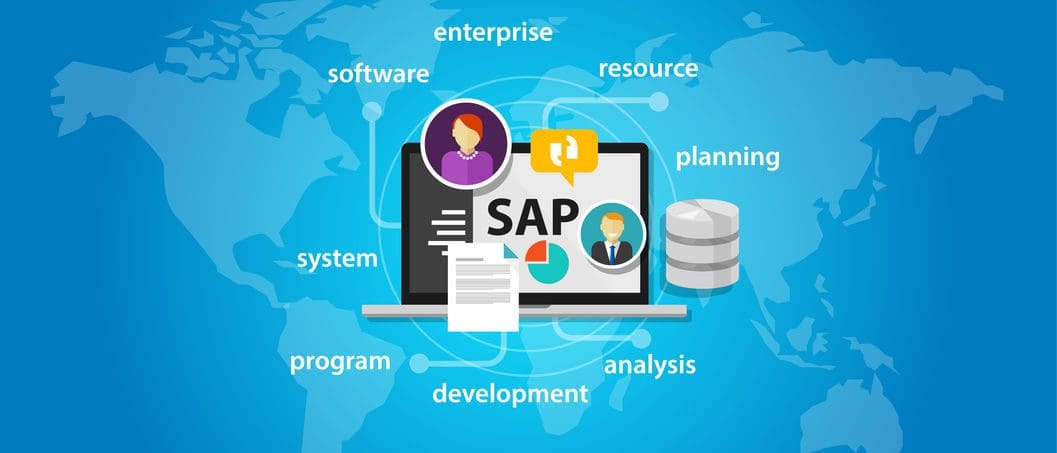SAP’s S/4HANA platform is the latest version of SAP’s industry leading ERP platform. Because this new platform was engineered very differently from previous iterations of SAP to maximize the technical capabilities of the HANA in-memory database technology, existing and new SAP customers face some strategic challenges in how to approach implementation of this software. For some time, SAP has commanded a significant market share of the ERP market for the large players in the oil and gas, power, chemicals and utilities industries.
Recently, the combination of sustained investment by SAP and major investments by larger customers in the industry to support recent implementations has also helped make the SAP offering increasingly attractive to small and midsized organizations. Given the cost and impact of a SAP implementation, both new and existing companies must find more affordable and lower-risk approaches to deploying S/4HANA that will align with their broader digital strategy. In this article, several of those implementation themes are highlighted and their relative strengths and weaknesses are discussed by deeply experienced and industry leading SAP implementors.
Migrate to S/4HANA as a Digital Enabler
Legacy ERP systems, traditional E/CTRM applications and custom enterprise solutions built on aging midrange or mainframe technologies are often poorly suited to serve as a platform for innovation. On the other hand, a move to S/4HANA for its own sake will not generate the kind of enterprise value necessary to justify an IT investment, nor will it contribute to the success of a company’s overall digital strategy. Breaking the migration into discrete pieces that each drive direct benefit and service the digital vision is necessary to secure funding, scope and staff the project, as well as manage delivery risk. Each of the steps analyzed below can stand on their own. They also represent meaningful steps along a process of increasing digital maturity that can be paced appropriately according to the appetite and ability of an organization.
Simplify the Financial Backbone
A positive initial project to charter as part of a digital transformation journey with an S/4 migration at its core will be targeted at the simplification of a company’s backbone of financial processes and technology. The exercise will serve as an important opportunity for the business and IT teams to learn about the solution set along with new ways of delivering IT projects (e.g., Agile). Moreover, a leaner back-office will produce tangible benefits that can fund the future while also creating new agility to more quickly address M&A opportunities, start-up new businesses and capitalize on disruption thanks to an extensible common process and technology template. To get started, below are a few basic pathways:
- Centralize classic ERP finance information such as the general ledger, receivables, payables, intercompany, etc. to S/4 with central finance. This step will begin to build the IT and business teams’ skillset on the new solution setting up success on future initiatives.
- Utilize the SAP model company and best practices as starting points to reduce inefficiency and strip out expensive legacy customizations. A key benefit from this effort will be a reduction in maintenance and support obligations. Doing so will free key people to pursue subsequent investments building on the backbone.
- Consolidate applications in the finance and accounting domain by folding in capabilities such as cash management, liquidity forecasting, compliance and others, progressively retiring legacy solutions. The savings in annual software maintenance and infrastructure costs can be reinvested back in the digital program.
Provide Foundational Technology Capabilities
Successful digitization of an energy business demands a certain set of foundational technology enablers. These tools need to be framed in the appropriate process context and surrounded with people that possess knowledge, skills and abilities to leverage them in order to construct the particular solutions envisioned now, as well as those still years from definition. To build the architectural framework:
- Establish an API strategy and implement the suite of tools for enterprise process and data integration using solutions such as MuleSoft, Jitterbit or Dell Boomi. Reusable APIs and services constructed in this way will reduce the future investment necessary for cloud enablement or to capture value from emerging opportunities.
- Solidify master and reference data management and associated governance to streamline cross-solution processing, as well as enhance facility with reporting and analytics. Cleaner data will translate into less time spent by IT and business users troubleshooting integration failures, reconciling or producing reports offline from heterogeneous data sets, which will free them to seek out new ways to create value.
- Introduce a big data platform such as Hadoop and Spark and overlay them with a comprehensive semantic layer so that financial and operational data can be combined in new ways to support analytics and provide the raw material for pursuits in artificial intelligence (AI) and machine learning.
- Provide for self-service analytics on top of a big data platform using tools like Jupyter to get the most from R, Python and/or Scala. This will allow your data scientists to produce business insights. Even if they can’t be monetized immediately, these insights will often prove to be the seed for future digitization opportunities.
Move Non-Core Capabilities to the Cloud
There are seemingly countless things a business must do in the course of day-to-day operations that aren’t key to differentiating themselves from their competition, but that benefit materially from simplification, standardization, improved reliability and mobility. These processes, and the supporting technology, represent leading candidates for an early migration to the cloud. The resulting initiatives can be important proving grounds for new concepts before they are deployed against more critical value drivers.
- Investigate functional domains such as procurement, recruiting, payroll, benefits, contingent workforce management, etc. and identify leading opportunities to secure quick wins in the cloud. Each scenario will afford its own slate of benefits to be realized.
- Execute projects to shift to cloud-leveraging offerings from the SAP ecosystem and beyond such as Arriba, SuccessFactors, Fieldglass and Salesforce.
- Integrate these cloud solutions into your environment leveraging the API framework previously established and add the data they provide to your big data foundation to continue building analytics momentum while setting the stage for future optimization and process automation.
Optimize & Automate Business Processes
One of the long-promised benefits of digitization has been operational excellence and efficiency. Attaining new levels of operational excellence and realizing the efficiencies requires IT to build upon enabling technologies and partner with business units to optimize and automate processes.
- Use your company’s expertise in process improvement via the application of Lean, Six Sigma, ISO 9000, etc. to simplify ways of working, minimize hand-offs and reduce the number of actors across the transaction lifecycle. This step represents an excellent example of one that can be pursued at any and every point along the roadmap to produce impactful results.
- Automate processes that benefit least from a direct human involvement standpoint using robotic process automation (RPA) solutions from the likes of Blue Prism or UiPath to create organizational capacity to pursue higher-value activities. The investment made in APIs will accelerate time-to-value on these initiatives, paying back the investment previously made.
- Ensure process quality and discover additional opportunities to reduce friction points by connecting a process mining solution such as Celonis to the operational systems most heavily exercised by key processes.
Adopt S/4HANA-Based ERP, Industry Solution Components & Close Gaps
Slightly delaying gratification from the implementation of some of the more attractive solutions in SAP’s solution suites for the energy industry may be beneficial for small-to-midsized companies as it will afford them time to lay the foundation to extract greatest benefit and allow other well-resourced entities to work through remaining functional gaps in the offerings. SAP has made significant progress in extending the core solution to cover gaps unique to the industry in physical operations (via the TSW module) and commodity trading and risk (via SAP Commodity Management) – though many clients will likely require extension and enhancement to satisfy more niche requirements in those process areas.
- Identify the compliment of S/4HANA-based industry solutions that are well-suited to the company’s business model today, as well as in the foreseeable digital future, and initiate projects to adopt these modules in a manner similar to the way the financial backbone was addressed.
- Determine key remaining solution gaps in high-specialized areas such as risk management or renewable fuels compliance.
- Leverage API framework to build, deploy and integrate ecosystem partner applications such as Lacima, best-of-breed solutions from vendors like SAS or proprietary bespoke applications to close critical gaps.
Digitize & Differentiate
The chain of steps outlined above will help bring the organization to a point where the pieces are in place to accelerate innovation unencumbered by the shackles of outdated technology platforms and sub-optimized business processes. It’s at this point that IT and its business sponsors will be able to rapidly bring to bear next-generation tools like natural language processing, AI and machine learning on a robust digital-enabled IT capability set. These new applications will enable the enterprise to differentiate products and services from the competition.
Conclusion
A digital roadmap for your company may primarily focus on one of these themes, but it likely will involve some elements of all themes. The steps for realizing that roadmap don’t have to be completed across the enterprise in a linear fashion before proceeding to the next stage. Some companies may choose to build depth along the roadmap in key domains to enable early differentiation in certain strategic areas. Moreover, most of the steps will involve multiple iterations and will likely be revisited a number of times in the course of a company’s digital transformation program. Carefully partnering with solution and service providers that have an intimate understanding of the energy industry can serve to maximize the potential return from a company’s investment in digitization by shaping the roadmap and delivering on the promise of its constituent parts.
Stephen Bell is a Managing Director in Opportune’s Process & Technology practice. Stephen is an industry veteran with over 20 years of experience working for many of the largest oil and gas companies in the world. His experience includes developing IT solutions for downstream, chemicals and upstream business sectors. During his career, he has led several successful efforts to extend and innovate on base SAP capabilities to meet the business requirements across the petrochemical supply chain, including trading, risk management, primary and secondary distribution, fuels marketing, retail, lubricants pricing, crude marketing and sales, and feedstocks and chemicals. Stephen holds a B.S. in Economics from the Wharton School of Business from the University of Pennsylvania.
Kent Landrum, Managing Director in Opportune LLP’s Process & Technology practice who leads the firm’s Downstream Sector, has 20 years of diversified information technology experience with an emphasis on solution delivery for the energy industry. Kent has a proven track record of managing full life cycle software implementation projects for downstream and utilities companies, including ERP, ETRM, BI, MDM, and CRM. Prior to rejoining Opportune, he served as a Vice President & Chief Information Officer for CPS Energy. Kent holds a B.S. degree in Computer Science and Economics from Trinity University and a master’s degree in Organizational Development from the University of the Incarnate Word.







